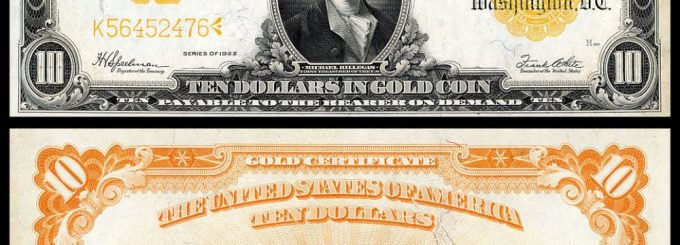Currency Spotlight: 1922 $10 Gold Certificate

The USA first begin issuing gold certificates during the outbreak of the Civil War in the 1860s. However, no certificates with a $10 dollar denomination were introduced until 1907. The 1922 version is especially sought after by collectors since it marks the final large sized certificate that was ever printed. By the late 1920s American currency was reduced to the size most are familiar with today.
Currency Highlights
This bill showcases a portrait of Alexander Hamilton and is distinct for its orange and yellow coloration. Michael Hillegas, who was the very first U.S. Treasurer, also appears on the 1922 and 1907 versions. Each note has a signature from Speelman & White, and some bills display serial numbers which are smaller than usual. In regards to value, any note that displays a smaller serial number does command a slightly higher premium. Every $10 certificate from 1922 has a golden seal, and the letter “X” can be seen on the left side.
Background
By 1834 The U.S. Congress needed a way to resolve the problems that were created by the fifteen to one silver/gold ratio, and made the decision to use gold coins for domestic commerce. However, the Gold Standard didn’t officially emerge in the U.S. until 1879. The government begin minting gold coins but also released gold certificates that could be converted into the physical metal.
A gold certificate was essentially a promise that the holder would be paid in gold on demand. There are a number of reasons why these certificates caught on. The first was convenience. It is much easier to carry around a paper certificate than the physical gold itself, and there was also the issue of security. The gold was held and guarded in a secure location where it was protected from theft or loss. The certificates were redeemable based on the current market value for gold at the time redemption took place. The gold certificate, which by 1900 was also known as the gold dollar, was declared by the U.S. government to be a standard account unit, and that every other form of money should be maintained in like parity. Other forms of money which were available included green backs, silver dollars and silver certificates.
Grades And Value
Although these certificates were only issued for a short time, millions were produced. And when a certificate is issued in such huge numbers, the primary factor which determines its collector value is condition. Star notes were produced, and are somewhat common compared to other notes of the same size. Any $10 certificate that has a serial number lower than one hundred commands higher value.
A lot of the 1922 gold certificates have margins that are either lower or tight near the top. That means these bills will typically be graded between 65 and 66. Gem Uncirculated bills which are 66 or above will usually be hard to find. The most common grades are between 63 and 65. Because millions of these certificates were printed, there are hundreds which have been preserved in mint condition.


